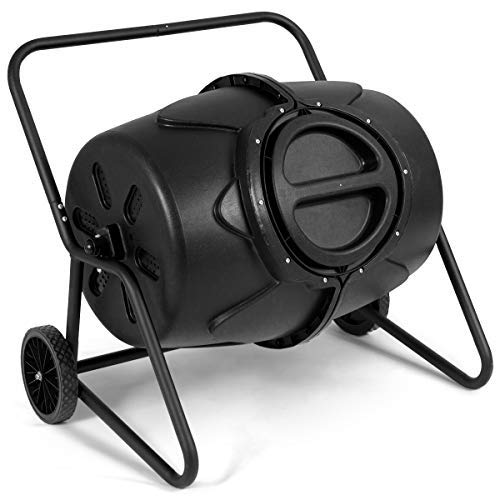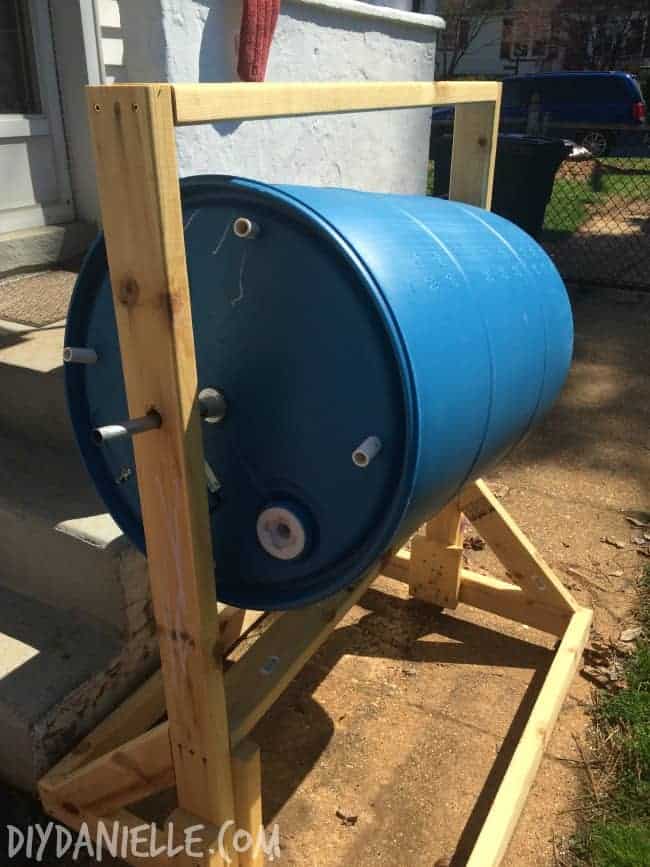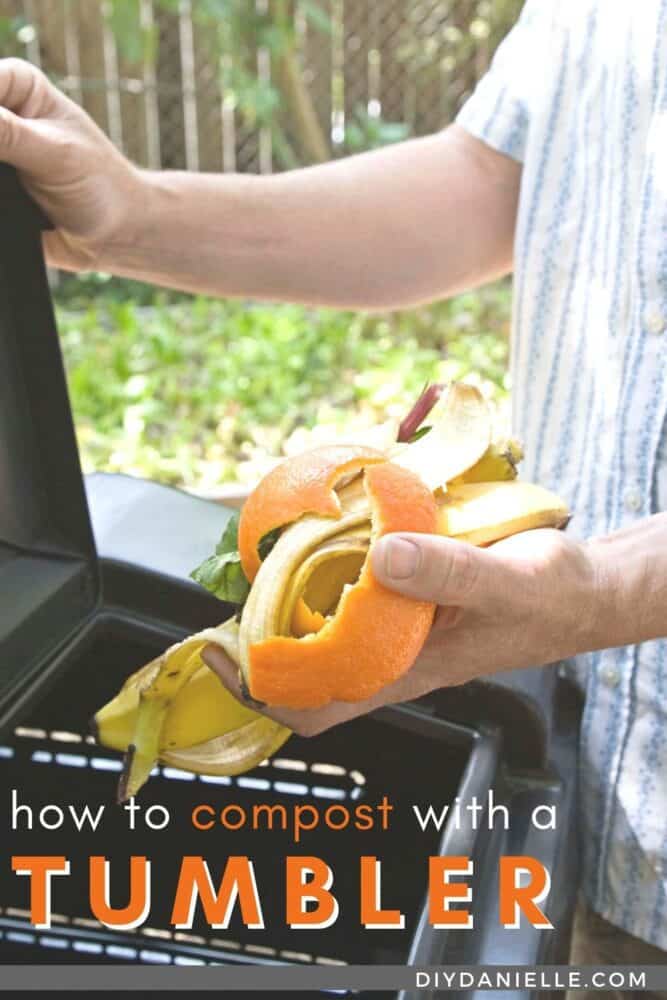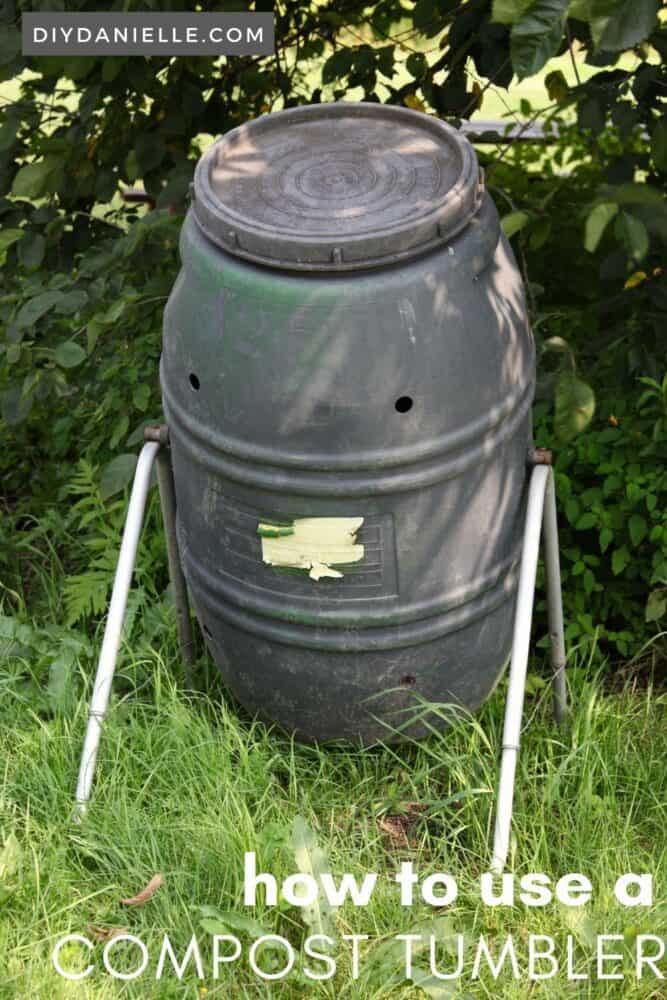How to compost in a tumbler. These compact compost bins provide an attractive alternative for personal composting for your garden.
I love composting. It’s a great way to reduce how much garbage we produce, and sending food scraps to the compost bin instead of the garbage can reduces a lot of smells in our garbage can. I have tried several different methods of composting including our tumbler compost bin, our open compost bin, and a worm bin composting.
A tumbler compost bin is probably one of those most subtle, attractive options for home gardeners. You can compost without neighbors complaining, and if you correctly care for your tumbler, it will produce compost quickly.
Homemade compost is far superior to expensive products that stores sell to encourage plant growth. It’s ecofriendly and has less of an environmental footprint than buying compost from other sources.
By far, learning to compost has been the BEST thing I’ve done to improve my gardens. I’ve had much better success using compost as a natural fertilizer. The growth has been mind-blowing.
Tumbler compost bins are best for people with small gardens, and for people who produce fewer compostable materials. As our homestead has grown, we’ve upgraded our compost setup to larger scale options so we can compost the 31 pounds of poop that my horse produces each day, excess animal bedding, etc. A tumbling bin simply wouldn’t cut it here. We could easily, however, compost what our household of 6 produces with a two or three tumbler bin setup.
This post may contain affiliate links which may earn me commissions should you click through them and take certain actions. As an affiliate for Amazon, Cricut, xTool, Home Depot, and other sites, I earn from qualifying purchases. Please DIY carefully. View my full legal disclosures here.
Please read the whole post so you don’t miss any important information!
Compost Tumblers
What is a Tumbler Compost Bin?
Tumbler compost bins are closed and have a small door that opens to put compost inside. You can turn them using a lever or by pushing them around your yard. They’re usually black or another dark color to help attract and retain heat; heat is an important part of the composting process.
Some bins have holes for water to seep through and for excess water to run out. Moisture is another important part of composting– you don’t want too much or too little, particularly in a closed tumbling bin. Most produce, however, will add moisture to the compost inside, so you shouldn’t need to add water frequently. This will depending entirely on the climate so keep an eye on the moisture level and add water if your compost gets too dry.
Most composting methods involve worms- either naturally or from the soil. Our largest compost pile, for example, is accessible to worms and other critters (including our chickens who claw through it) due to having no barriers between the earth and the pile.
Unlike those other methods, tumbler bins can’t use worms to process the compost. The tumbler would get too hot or too cold for the worms to survive. Fortunately, there are lots of microorganisms who CAN survive and will happily do the composting work in your bin.
Aeration helps improve composting rates. In a tumbler bin, you provide the aeration when you turn the bin. If you turn a few times a week, tumblers should compost more quickly than an open bin.
Make sure that the bin you purchase or make can be turned easily with the bulk of the compost inside it. I had a tumbling bin with a base but no handle for turning. It was low to the ground which made it difficult to turn. To turn it, we would remove it from the base and have the kids roll it around the yard. It was effective, but dirty work, and we didn’t turn it enough as a result.
Pros and Cons of a Compost Tumbler
Pros of a Tumbler
- Processes faster than open bins.
- Enclosed, easier to hide what they are from neighbors who might oppose a compost bin or pile
- Keeps animals out.
- Keeps wind from blowing away light items such as shredded paper.
- Easy to turn (if you get a good one)
Cons of a Tumbler
- Smaller and hold less compost than an open bin.
- Must add water for moisture.
- More expensive.
- Harder to fill because of the small doors that they have.
- Doesn’t process as fast as the worm compost bin.
- Some are very hard to turn when full.
- Don’t get as much air flow as an open bin.
Tips for Purchasing a Tumbler Compost Bin
There are a few things to keep in mind when purchasing a tumbler compost bin:
- Bigger may not be better if it’s harder to turn due to the weight. It’s better to get two smaller bins than one large bin.
- The bins must be sturdy; plastic or metal seems best.
- How big is the “door” to access compost materials? Can you easily empty the compost out to use? Can you easily shove materials inside the bin?
- Two bins allow you to switch which bin you place fresh compost into.
- Sometimes your county may provide a free or reduced cost bin to residents to encourage composting.
- Used bins are often available on local sale sites like NextDoor, Facebook Marketplace, and Craigslist. It has a certain ‘ick’ factor to transport them, but if you get a good deal then it might be worth it. Throw a tarp down in the back of your car to keep the car clean. Some of the newer tumblers are better products though.
Compost Tumblers for Purchase
Tumbler Compost Bins
Not everyone will want to DIY a compost tumbler so here are some good options to purchase online. I am going to give my opinions on these, just from reading reviews and my experience with what I didn't like in my old compost tumbler. My personal take on these? I do NOT want to dig my hands in to get the finished compost out and I don't want to break my back spinning it either; I will pay for easy. Time is money and I would rather be doing work in the garden, rather than messing around with the compost bin.

RSI MCT-MC Maze Compost Tumbler, Black
This is my favorite option from the five here- I'd buy it. The composter is high enough to fit the wheeled container underneath. This allows you to dump finished compost into the bin to move to the garden easily. The handle allows for it to turn easily, although I wonder if the handle would withstand long term use and heavy compost. It's moderately attractive. There's two bins so you can have a bin for newer compost and another one for the old stuff. The "wheelbarrow" type container can fit underneath it.

Goplus Compost Tumbler Outdoor Garden Waste Bin Grass Food Trash Fertilizer Barrel Black (45-Gallon with Wheels)
I like that this has wheels and a handle. I imagine being able to tilt the bin makes it easier to turn, and I like the nice large entrance door that doesn't have a lot of hardware. It looks like it just screws onto the tumbler. You could probably roll this into the garden, open the door, spin it, and it'll empty directly to the garden.
The downside is you'll need two of these as there isn't a dual chamber. Turning may be hard on the back seeing it's so low. I'm also a bit concerned about the lack of ventilation / holes for rain water to get through and air circulation.

VIVOSUN Outdoor Tumbling Composter Dual Rotating Batch Compost Bin, 43 Gallon Orange Door
I like the dual chambers and the fact that it's as tall as me- this might make it easier to turn. Maybe. You may also be able to push a cart of some sort underneath to gather compost, seeing it's so tall.

Miracle-Gro Large Dual Chamber Compost Tumbler – Easy-Turn, Fast-Working System – All-Season, Heavy-Duty, High Volume Composter with 2 Sliding Doors - (2 – 27.7gallon /105 Liter)
I like the look of this and the dual chambers. The fact that the chambers appear to be split may allow for you to spin them separately which is nice because the compost won't be as heavy as spinning both at once. That said, many reviewers complained that the doors aren't attached with durable clips and you may need to 'hack' that to make it functional long term.

Hot Frog FCMP Outdoor 37 Gallon Chamber Quick Curing Rolling Compost Tumbler Bin for Soil
This has a small opening, according to reviewers, which can be a problem for scooping or inserting material. I anticipate it's not quite as easy to turn- this is similar to our first tumbler. We needed to grab the gaps and turn, but the heavy materials at the bottom make this heavy work.
Setting Up a Tumbling Compost Bin
Setup for purchased bins will depend on the product. You can also make your own bin. This is a bin that my friend’s husband made. I believe he also added holes around the barrel for drainage and water to come through. A food grade barrel works well with some pressure treated 2x4s. The downside to this style is that unloading finished compost may be more difficult.

Once you’ve put your bin together, just add compost. I recommend adding browns first. Fall leaves are fantastic, as is shredded white paper.
Caring for Your Tumbling Compost Bin
Turn turn turn. Whenever you can. Add moisture when dry. Make sure to add a good balance of nitrogen and carbon materials (get the free printable below).
Don’t forget- smaller bits compost faster. It might be helpful to use a food processor to chop up stuff like citrus peels. If you add paper, shredding it first can help it break down faster.
And it’s ALWAYS better to own TWO composters (or a bin with two sections) so you can add fresh compost to one while the other composts down older materials.
Cleaning Your Compost Bin
Cleaning your compost bin is generally unnecessary, although you may want to do so if you’re moving the bin to another home/property or selling it.
Personally, I would add excess browns for a week prior to soak up any wetness inside the bin. Old newspapers, leaves, etc. should do the trick. Turn daily.
Vinegar is an excellent cleaner that won’t be harmful to the environment. I’ve also used products like Blue Dawn. Take the hose out and use a CLEAN (brand new) toilet bowl scrubber to rub down the inside and outside of your compost bin. You can keep this for future cleanings! Use the cleaner of your choice, then rinse thoroughly with water.
Leave the bin out in the hot sun to dry for a few days before adding new compost.
How Does Composting Work?
Aerobes and anaerobes are microorganisms that break down compost into soil. This is what occurs naturally as animals, plants, and trees die. Often larger organisms such as birds may also help the process along, breaking down larger organic material into smaller bits. Once fully processed, everything returns to the earth, adding nutrients to the soil to help other things in that location grow. It’s a pretty beautiful process when you think about it.
Just to highlight how this works, consider a dead deer in the forest. Once the deer dies, the original hunter may take first choice of the meat while scavengers will follow up and eat the carrion. Whatever soft carrion remains will likely decompose quickly into the soil. Items like bones and antlers take longer to break down; worms and microorganisms usually do some of this work. A dog or other wildlife may chew on a bone it finds, but regardless, those bones will decay over time. In fertile soil, bone could take around 20 years to break down, but scientists have found bones from our ancient ancestors so there is no set time to expect those deer’s bones to disappear. Plants may grow out of the skeleton before it’s fully broken down and you’ll see good growth around these areas. The deer’s decomposition is feeding the soil, the microorganisms, and eventually we all benefit from this process. Perhaps another deer grazes in this fertile soil, later is hunted, and feeds the hunter’s family. Rabbits graze the area, then are eaten by a fox in the area. Are you humming “The Circle of Life” yet?
Back to the use of microorganisms in composting. Remember that our closed compost bins, such as compost tumblers, don’t have the benefit of larger critters helping to break down the contents. You’ll find bugs will find their way in (and out) of your tumbler, assuming it has proper drainage and ventilation holes. You may even find worms. I anticipate bins that are lower to the ground are more likely to encourage “helpers” moving in.
Anything we add to our compost that has density or weight to it is going to take longer to break down. Microorganisms simply take longer to get through it. These are items like watermelon rinds, large sticks, citrus peels, and cherry pits. Even paper can be slow to process.
If you want to speed the process up, help out the microorganisms by being the “larger critter” and breaking it down yourself. This could mean shredding the paper or using a food processor to break down a watermelon rind before putting it in your tumbler. I’ve been a bit starry eyed over the FoodCyclers that you keep in your house to break down compost, but the $400 price tag is a bit out of my budget… it’s one of those neat luxury items that’s fun to look at though.
What to Add to Your Compost Tumbler
My beginner composting guide is a good resource for what you can add to a compost tumbler or any compost bin, but I’ll cover the basics here.
The rules for all compost bins are generally the same- you want a balance of green and brown materials, you shouldn’t add anything that will attract bears, smaller bits break down faster, and nothing should enter the bin that will introduce disease to your garden (like human, dog, or cat poo). A lot of this is common sense, if you think it through.
Green vs. Brown Materials
First, green materials are products that add nitrogen to your compost. Brown materials add carbon.
“Brown” materials tend to be dry, woody items… sawdust, straw, old paper, etc. I think of brown materials as being “the dead stuff.”
“Green” materials are usually items like produce scraps, manure, and grass clippings.
You want more carbon (brown) than nitrogen (green) in your compost bin; this helps keep it from smelling and helps move things along for composting. Don’t worry though- if it goes in the wrong direction, you can fix it. It does NOT need to be an exact science.
Don’t Attract Bears
It’s 3am and you hear a CRASH outside. Did you add meat products to your tumbler? If so, a bear or another critter may be trying to get in for a snack. Don’t add meat or bones. They take a long time to break down and may attract the wrong kind of attention. They’re also more smelly.
Small Bits Break Down Faster
If you’re patient, this doesn’t matter. But if you cut up stuff into smaller bits, they break down faster in your compost bin. Shredding paper, using a blender to breakdown citrus peels or watermelon rinds, etc. will help get you some usable compost faster.
The No Poo Rule
Dog poo, cat poo, and human poo cannot be composted in your bin. Some animals simply are more likely to carry pathogens that, should they get on your garden produce, may introduce disease to your family. Most diseases will die in the heat of a compost bin, but the kinds that are carried by humans, dogs, and cats may not. Composting those types of products takes a higher heat than you can naturally produce at home in a tumbler.
Compost Printable
Want a free printable with a list of ideas to put in your compost bin? Sign up below!
Other Posts about Composting Methods:
- Aerated Static Compost Bins
- Composting 101: How to Start Composting
- Open Bin Composting
- Worm Bin Composting
Please share and pin this post! If you make this project, share it in our Stuff Mama Makes Facebook Group. We have regular giveaways for gift cards to craft stores. You can also tag me on Instagram @doityourselfdanielle; I love seeing everything you make!



Learn about Worm Composting
Monday 9th of April 2018
[…] Tumbling composters […]